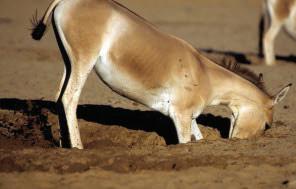
4 minute read
Wells dug by horses and donkeys are a welcome sight for other animals in U.S. deserts
LIFE & EVOLUTION Equids supply water to thirsty wildlife
Wells dug by feral donkeys and horses may help ecosystems
Advertisement
BY JONATHAN LAMBERT
Water drives the rhythms of desert life, but animals aren’t always helpless against the whims of weather.
In the American Southwest, wild donkeys and horses often dig into the dusty sediment to reach cool, clear groundwater to quench their thirst. New research shows that this equid ingenuity has farreaching benefits for the ecosystem.
Equid wells can act as desert oases, providing a major source of water during dry times that benefits a whole ing dry times that benefits a whole host of desert animals and trees, host of desert animals and trees,
LIFE & EVOLUTION Antibiotic slows a fatal coral disease
Amoxicillin is 95 percent e ffective at halting tissue loss
BY CASSIE MARTIN
Slathering corals in a common antibiotic seems to soothe a mysterious tissueeating disease, new research suggests.
Just off Florida, a type of coral infected with stony coral tissue loss disease, or SCTLD, showed widespread improvement several months after being treated with amoxicillin, researchers report April 21 in Scientific Reports. While the deadly disease eventually reappeared on some treated corals, the results provide a spot of good news while scientists continue the search for what causes it. r esearchers report in the April 30 Science.
Introduced to North America in the last 500 years or so, wild donkeys and horses are often cast as villains in the West. These species can trample native vegetation, erode creek beds and outcompete native animals. But when Erick Lundgren, a field ecologist at Aarhus University in Denmark, first observed wild donkeys digging wells in 2014, he wondered whether these holes might benefit ecosystems, similar to the way elephant-built water holes can sustain a community in the African savanna.
“Because of the way we value [feral] horses and donkeys, the orthodoxy tends to focus on how they harm ecosystems,” he says. “We wanted to see whether these holes provided a resource when water is scarce.”
Over the course of three summers from
Divers discovered SCTLD on reefs near Miami in 2014. Characterized by white lesions that rapidly eat away at coral tissue, the disease plagues nearly all of the 580-kilometer-long Great Florida Reef and has spread to reefs in the Caribbean (SN: 8/3/19, p. 14).
Since the cause is unknown, scientists are left to treat the lesions through trial and error. Two treatments that show promise involve divers applying a chlorinated epoxy or an amoxicillin paste to infected patches. “We wanted to experimentally assess these techniques to see if they’re as effective as people have been reporting anecdotally,” says Erin Shilling, a coral researcher at Florida Atlantic University’s Harbor Branch Oceanographic Institute in Fort Pierce.
In April 2019, Shilling and colleagues identified 95 lesions on 32 colonies of great star coral (Montastraea cavernosa) 2015 to 2018, Lundgren and colleagues mapped out the surface area of water in wells and groundwater-fed streams at four sites in Arizona’s Sonoran Desert.
Water availability was highly variable among sites, but equid wells generally increased accessible water, especially as temperatures rose. At one site, wells were the only source of drinking water once the local stream completely dried up. Elsewhere, wells provided up to 74 percent of available surface water. Wells also decreased the distance between water sources by an average of 843 meters, easing tensions that can escalate among drinkers at isolated water holes, Lundgren says.
Once wells were dug, other animals came in droves. Cameras staking out wells, riverbanks and dry spots at five sites in the Sonoran and Mojave deserts documented 57 vertebrate species, from migratory songbirds to mountain lions, slurping at the wells. That’s about equal to the number of species seen at streams and 64 percent higher than at dry spots.
“We even caught a black bear drinking from a well,” says Lundgren, who also takes swigs from the wells from time to time. “The water is quite cool,
off Florida’s east coast. The scientists dug trenches into some of the corals around the lesions to separate diseased tissue from healthy tissue, then filled the moats and covered the diseased patches with the antibiotic paste or chlorinated epoxy.
Within about 11 months of the treatment, some 95 percent of infected coral tissues treated with amoxicillin had healed. Meanwhile, only about 20 p ercent of infected tissue treated with chlorinated epoxy had healed in that time — no better than untreated lesions.
But a one-and-done treatment doesn’t stop new lesions from popping up over time, the team found. And some key questions remain unanswered, including how well the treatment works for more coral colonies and species, and what l ongerterm side effects the antibiotic could have on corals and their e nvironment.
Donkeys and other equids, like this kulan in Central Asia, dig wells in search of water. Such wells in the American Southwest may benefit ecosystems by boosting water access.










